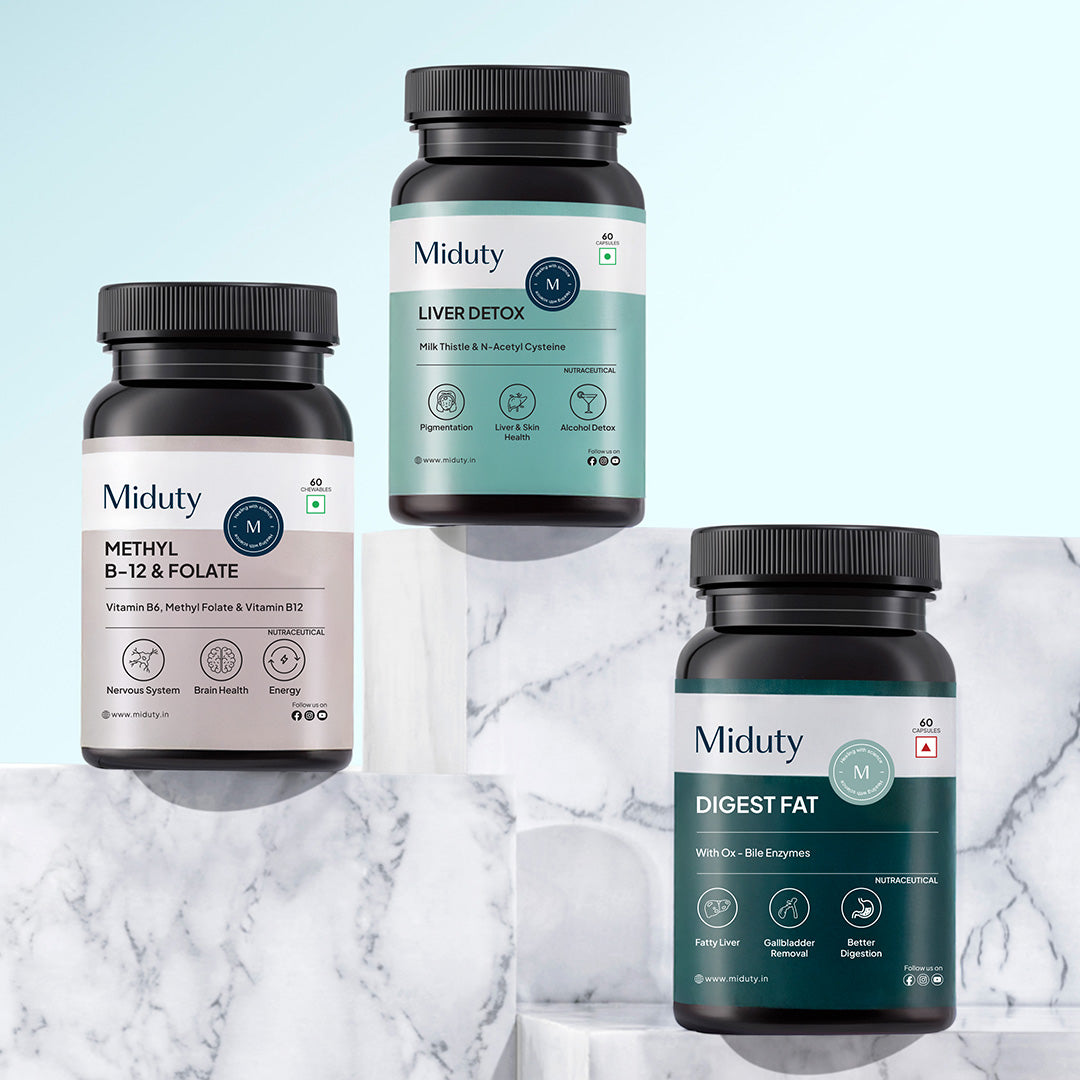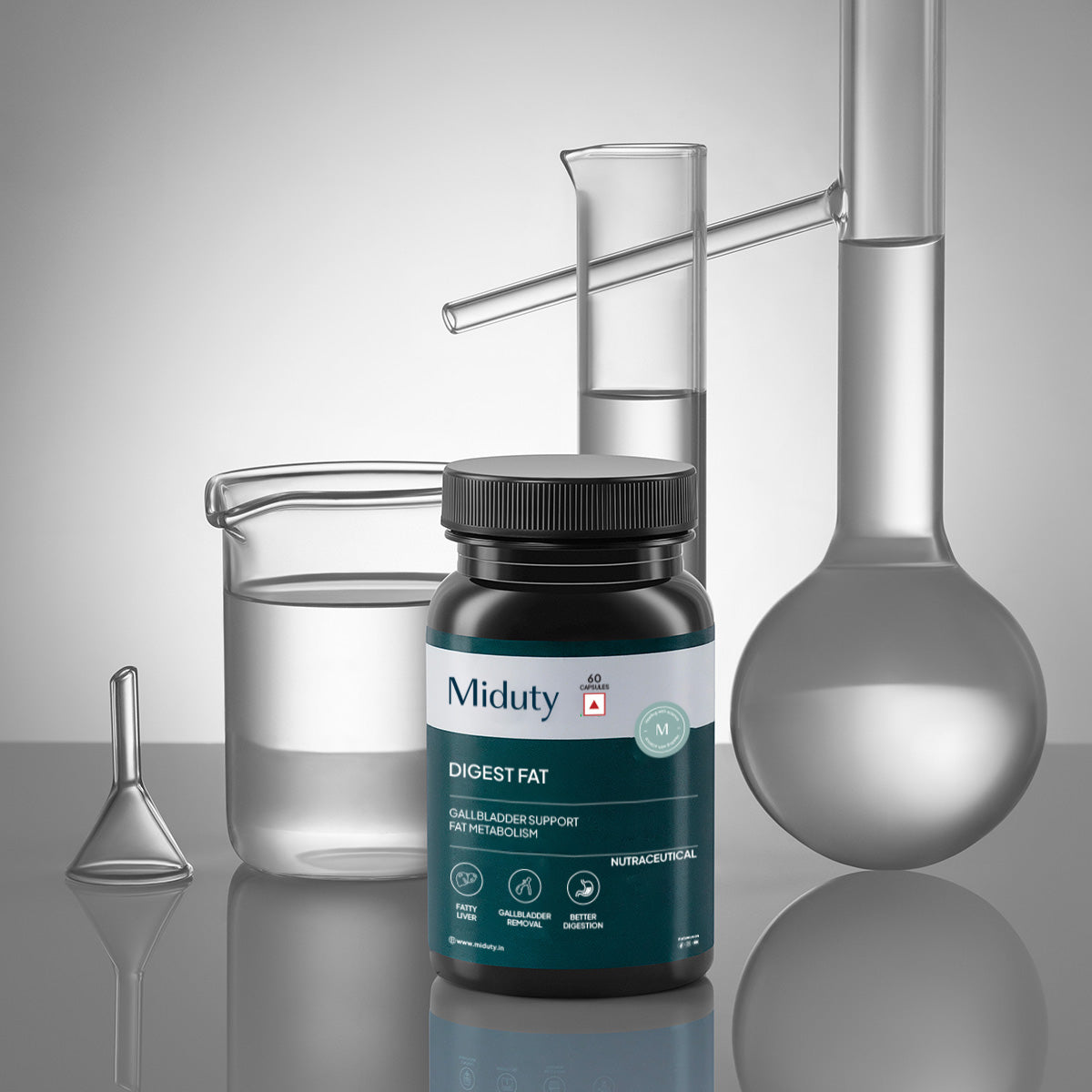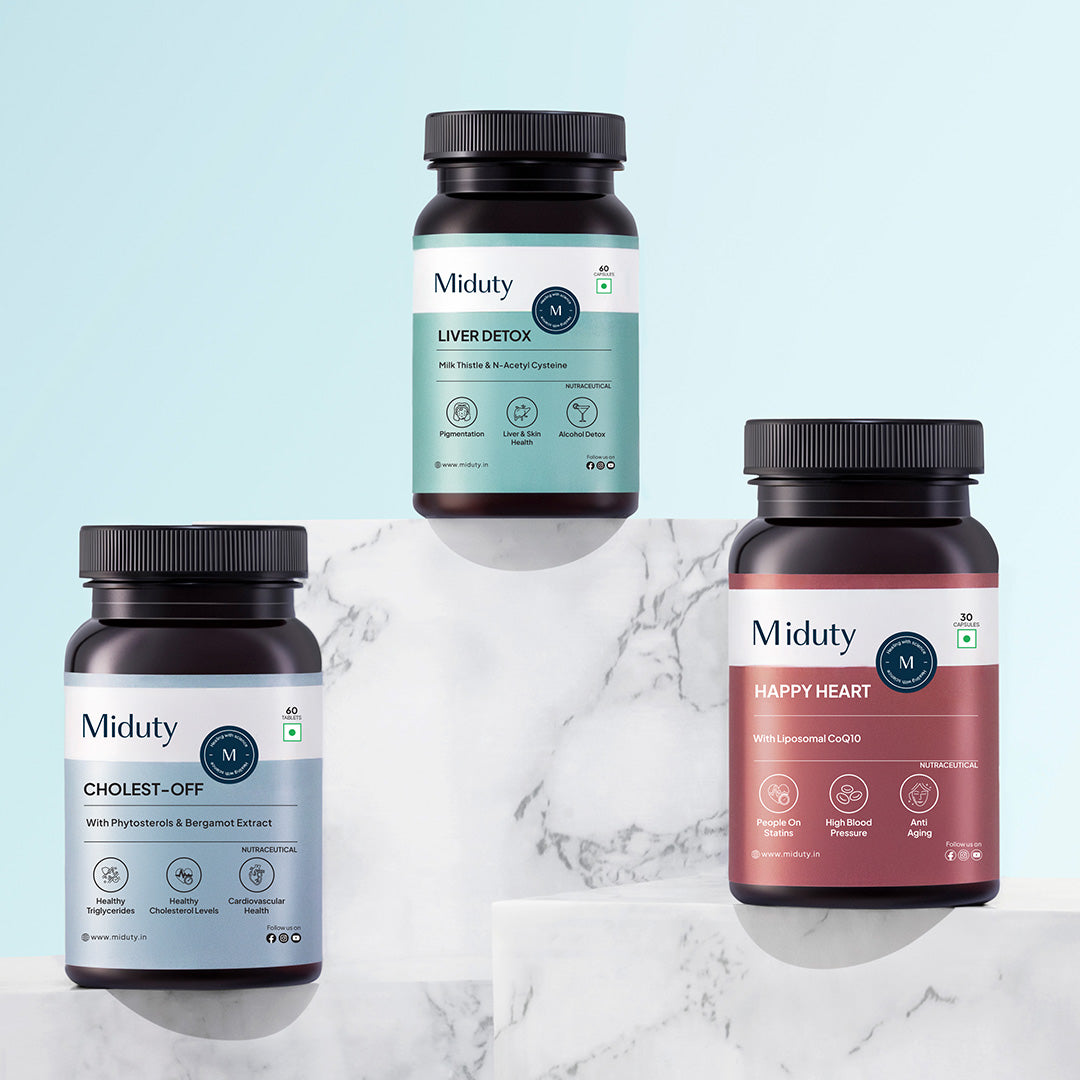
Grade 1 Fatty Liver - Causes, Symptoms, and Best Treatment Tips
Key Takeaways
1. Understanding Grade 1 Fatty Liver: Learn about the causes, symptoms, and potential health risks of Grade 1 fatty liver, which affects up to 32% of the Indian population.
2. Natural Treatment Tips: Discover 8 effective natural remedies to reverse Grade 1 fatty liver, including lifestyle changes, diet modifications, and liver-friendly supplements.
3. Symptoms to be Aware of: Be aware of early signs like fatigue, mild abdominal discomfort, and occasional nausea that can help in the early detection of fatty liver.
4. Diet and Lifestyle Recommendations: Get practical advice on incorporating a balanced diet, regular exercise, proper sleep, and specific herbs and spices to support liver health.
5. Prevent Progression: Understand the importance of early intervention to prevent Grade 1 fatty liver from progressing to more severe conditions like cirrhosis or liver cancer.
Did you know that up to 32% of the Indian population may be affected by fatty liver disease?
It's often called a "silent and dangerous" disease because it develops without noticeable symptoms but can have significant health consequences if ignored. [1]
Are you worried about your liver?
How can you detect fatty liver early?
What are the best strategies to cure grade 1 fatty liver?
Understanding the risk factors is crucial. Obesity, diabetes, high cholesterol, and a sedentary lifestyle can all contribute to the development of fatty liver. Early detection is key, and it starts with being aware of subtle signs like fatigue, abdominal discomfort, or elevated liver enzymes found in routine blood tests.
What is Fatty Liver?
Fatty liver, or hepatic steatosis, occurs when excess fat builds up in the liver. [2] Fatty liver can quietly progress to inflammation, liver damage, and even liver failure if left unchecked.
There are two main types of fatty liver disease: Non-Alcoholic Fatty Liver Disease (NAFLD), which is often linked to obesity and diabetes, and Alcoholic Fatty Liver Disease (AFLD), primarily caused by excessive alcohol consumption.
With the liver playing a crucial role in detoxification, metabolism, and nutrient storage, maintaining its health is vital for overall well-being.
What is Grade 1 Fatty Liver?
Fatty liver disease is categorized into different grades based on fat accumulation and liver damage. Fatty liver grade 1, also known as mild fatty liver, marks the earliest and least severe stage of fatty liver disease.
At this initial stage, less than 33% of liver cells are infiltrated with fat deposits, causing minimal to no liver damage.[3] Although it may sound harmless, this silent condition can be a red flag for future liver issues if ignored.
The good news is that grade 1 fatty liver is reversible with the right lifestyle changes. By adopting a balanced diet rich in fruits, vegetables, and lean proteins, incorporating regular physical activity, and avoiding alcohol, you can restore your liver health.
Additionally, understanding the role of specific nutrients and supplements can further support liver recovery.
Consequences of Untreated Grade 1 Fatty Liver

If untreated, grade 1 fatty liver can progress to more severe conditions:
Steatohepatitis: Fat accumulation causes liver inflammation, known as non-alcoholic steatohepatitis (NASH).
Fibrosis: Fibrosis develops when chronic inflammation leads to liver scarring. While the liver can function fairly well at this stage, untreated fibrosis can progress to irreversible cirrhosis. [4]
Cirrhosis: Cirrhosis is an advanced stage of liver scarring, where healthy liver tissue is replaced by fibrotic tissue, severely impairing liver function.
Liver Cancer: Chronic inflammation and cirrhosis greatly increase the chances of developing liver cancer. The most common type, hepatocellular carcinoma, can develop after long-term liver damage. [5]
Liver Failure: Liver failure occurs when severe liver damage impairs its ability to function properly, posing a life-threatening situation that may necessitate a liver transplant.
Symptoms of Grade 1 Fatty Liver
|
Symptoms |
Description |
|
Feeling Unusually Tired or Weak |
Feeling fatigued even after adequate rest |
|
Mild Pain/Discomfort Under Right Ribs |
Mild ache or discomfort on the right side of the abdomen, where the liver is located |
|
Occasional Nausea |
Periodic feeling of uneasiness especially after meals |
|
Heartburn, Bloating, Indigestion [6] |
Symptoms of gastrointestinal discomfort, such as acid reflux and abdominal swelling. |
|
Changes in Appetite, Feeling Full Quickly |
Alteration in hunger levels or feeling full quickly during meals. |
|
Consuming fruits containing fructose [7] |
High intake of fructose-rich fruits can contribute to fatty liver development |
Causes of Grade 1 Fatty Liver
|
Cause/Risk Factor |
Description |
|
High intake of refined carbohydrates, sugars, and unhealthy fats |
Sugary beverages (sodas, energy drinks, fruit juices) |
|
Elevated triglycerides and LDL cholesterol [8] |
High levels of these lipids in the blood increase fat accumulation in the liver. |
|
Insulin Resistance |
Higher insulin levels promote fat storage in the liver |
|
Excess body weight, especially abdominal obesity |
Being overweight, especially with abdominal fat, is strongly associated with fatty liver development. |
Grade 1 Fatty Liver Treatment: Tips to Reverse Fatty Liver Naturally
1. Change Your Lifestyle
When addressing symptoms of fatty liver, it's crucial to avoid approaches that prioritize reducing water weight or muscle mass, as this can lead to severe nutritional deficiencies. It's important to note that fatty liver can occur even in individuals who appear slim, due to diets high in processed and deep-fried foods. [9]
Instead, prioritizing regular exercise like walking, cycling, or swimming not only aids in reducing liver fat but also helps build muscle mass and boosts metabolic rate, which supports overall fat reduction and liver health.
2. Maintain a Proper Sleep Cycle

Sufficient deep sleep is essential for reversing grade 1 fatty liver, as it allows the body to undergo crucial repair processes. Aim for 7-9 hours of uninterrupted sleep nightly, maintain a consistent sleep schedule, and establish a calming bedtime routine to support liver health effectively. [10]
3. Modify Your Diet
For grade 1 fatty liver, avoid harmful fats found in high-carb diets with additives like high fructose corn syrup and glucose syrup. Substitute with stevia or monk fruit, which don't spike blood sugar and can reduce liver fat. Use extra virgin olive oil for salads and light sauteing, as it supports liver health. [11]
Include berries, leafy greens, citrus fruits, and cruciferous vegetables in your diet while cutting back on sodium and opting for healthy fats like avocados, nuts, seeds, and olive oil.
4. Avoid Refined Seed Oils
Switch from seed oils, which can aggravate grade 1 fatty liver symptoms by causing inflammation, to cold-pressed coconut oil. [12] This change can support liver health and reduce inflammation levels in the body.
5. Use Spices and Herbs

Including anti-inflammatory spices like turmeric (curcumin), ginger, garlic, and cinnamon in your diet can benefit grade 1 fatty liver treatment by supporting liver health and reducing fat accumulation.[13] Additionally, dandelion root tea is known for its liver-cleansing properties, aiding in detoxification and enhancing liver function.
6. Adopt an Intermittent Fasting Schedule
Intermittent fasting, like the 16/8 method (16 hours fasting, 8-hour eating window), improves insulin sensitivity and aids weight loss, crucial for reversing grade 1 fatty liver causes. Check out this video guide on starting intermittent fasting for more details.
7. Consume Probiotics and Fermented Foods
Foods such as yogurt, kefir, sauerkraut, kimchi, and kombucha promote gut health, which is closely tied to liver health. A balanced gut microbiome can help decrease liver inflammation and prevent fat accumulation.
8. Take Liver-Friendly Supplements
To halt the progression of grade 1 fatty liver naturally, focus on addressing its root causes without relying solely on medications. Incorporate Liver Detox supplements into your routine, designed with liver-friendly ingredients like NAC for antioxidant support and Milk Thistle for detoxification. [14], [15]
Additionally, for speedy recovery consider incorporating supplements with Ox-Bile Enzymes that will help to aid digestion and fat metabolism, supporting gut health and gallbladder function.
For optimal nutrient absorption disrupted by fatty liver symptoms, consider supplements having the blend of B6, folate, and methylcobalamin to enhance tissue repair, combat fatigue, and support nerve function throughout the day.
Conclusion
Here are some intriguing facts to get you thinking:
- Studies have shown that around one in three Indians suffer from fatty liver disease, making it a significant public health concern.
- The increasing consumption of fast food, sedentary lifestyle, and stress associated with urban living are major contributors to the rise of fatty liver cases in India.
- While often linked to obesity, fatty liver grade 1 can also affect non-obese individuals in India, especially those with diabetes or metabolic syndrome.
- The good news is that with timely intervention through diet and lifestyle changes, fatty liver grade 1 can be managed and even reversed.
Here's a bonus tip! For those of you searching for the Fatty Liver Grade 1 diet, why not jump to a 4-week fatty liver diet plan to cure all fatty Liver Grade 1 symptoms naturally without going for medicine for fatty Liver Grade 1?
GUESS WHAT? IT'S A FREE DIET PLAN!! Grab it.
Frequently Asked Questions on Grade 1 Fatty Liver -
Q1. Can Grade 1 fatty liver cause diabetes?
Yes, it can impair the liver's ability to manage blood sugar levels, leading to type 2 diabetes if not managed properly.
Q2. Is coconut water good for the liver?
Yes, it's a low-calorie beverage rich in electrolytes, vitamins, and antioxidants that support liver function.
Q3. Is grade 1 fatty liver curable?
Yes, it is 100% reversible with the right lifestyle and dietary changes.
Q4. How do I know if my liver is recovering?
Signs of liver recovery include reduced fatigue, increased energy levels, and improved overall well-being. Positive changes in liver function can also manifest as improved blood sugar levels, lower cholesterol, and enhanced metabolic health. Monitoring liver function through tests that measure enzymes like ALT and AST in the blood can show decreased levels, indicating improved liver function.
References













